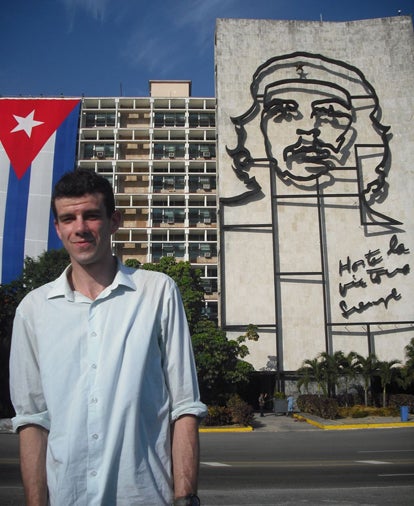Historian finds his inspiration in Cuba
 As a high school history teacher in New York City, Jesse Horst liked to think about the bigger picture: What were the processes driving urban politics behind the scenes? And how could he inspire inner-city students to get excited about something he loved?
As a high school history teacher in New York City, Jesse Horst liked to think about the bigger picture: What were the processes driving urban politics behind the scenes? And how could he inspire inner-city students to get excited about something he loved?
He began dabbling in night courses, testing the waters toward a graduate degree. And in the process, he managed to redefine his career path.
Alejandro de la Fuente, a professor from the Dietrich School’s Department of History, spoke at one of Horst’s classes where de la Fuente’s book, A Nation for All: Race, Inequality, and Politics in Twentieth-Century Cuba, was on the reading list.
“It was a class on Cuba, and his presentation just really interested me,” recalls Horst. “I thought, ‘That’s something I could spend years researching.'”
The key, he knew, was finding a topic about which he was passionate; Cuba fit the bill nicely. Having traveled to the country as an undergraduate, he was intrigued with its complexities. When he applied to graduate school, the University of Pittsburgh was at the top of the list, thanks in large part to de la Fuente’s speech. He arrived in the city sight unseen, but so far, the experience has dovetailed perfectly with his ambition.
Horst’s master’s thesis, which has provided the foundation for the focus of his PhD and has been accepted for publication by the Journal of Urban History, won the 2012 Jorge Pérez-Lopez Student Award from the Association for the Study of the Cuban Economy. He also presented the paper, “Shantytown Revolution: Slum Clearance, Rent Control, and the Cuban State, 1933-55,” at the Cuban Heritage Collection of the University of Miami in August 2012. The collection sponsored Horst for a summer research fellowship, allowing him to spend a month in Miami exploring its archives, which include the papers of expatriate Cubans who emigrated after the revolution.
Horst’s interest in the slums of Cuba was sparked by a class he took on Brazil with Distinguished Professor and history department chair Reid Andrews. The class studied the issue of slums in that country, inspiring Horst to ask: Did some of these issues occur in Cuba? He could not find any books about the topic, so he realized it was unexplored territory, ripe for a graduate student.
Horst examines the relationship between slums and the Cuban state from the 1930s until right before the country’s revolution: how various politicians developed programs for the neighborhoods, as well as the ensuing conflicts. As part of his research, he will spend a significant chunk of next year in Cuba gathering material for his doctorate.
“A history degree really does require a lot of digging. And in Cuba, some of the archives have suffered with the economic situation. It’s a painstaking process,” Horst says.
Thanks to recent reforms, people in private homes are able to rent rooms to foreigners, and Horst is looking forward to experiencing Cuba by living among its citizens. His previous visits as an undergraduate and a researcher whetted his appetite for more.
“It was really eye opening,” he says. “Cuba means so many things to different people. There’s all these big-picture ideas about Cuba, so it’s fascinating to actually go and talk to people and learn the details about what’s happening. It almost never lines up with other people’s ideas.”
When he completes his doctorate, Horst hopes to write a book based on his thesis and continue his research as a professor. He also wants to return to teaching, which he calls “one of the hardest jobs there is,” though he hopes to return at a collegiate level.
“It’s something that demands a lot of energy every single day, week after week after week,” notes Horst, whose four-year stint as a high school educator began with the Teach For America program. “So that can be challenging, but at the same time, I think it’s one of the most rewarding jobs. You can never be bored; the kids bring so much energy.”
